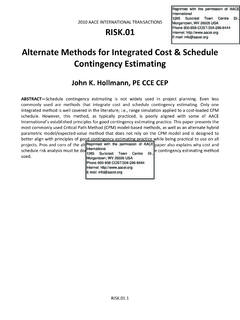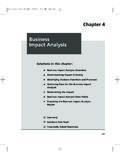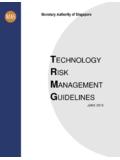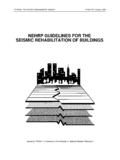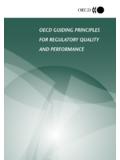Transcription of RISK.03 - The Monte-Carlo Challenge: A Better …
1 The definition of contingency and how to estimate itare among the most controversial topics in cost engi-neering. While there is consensus among cost engi-neers on what contingency is, there is much less con-sensus on how to estimate it. This lack of consensus and theunfortunate political nature of contingency issues partlyexplains why AACE International has never established a rec-ommended practice for how to estimate general, Industry can agree that there are four generalclasses of methods used to estimate contingency. These includethe following. Expert judgment. Predetermined guidelines (with varying degrees of judg-ment and empiricism used). monte Carlo or other simulation analysis (primarily riskanalysis judgment incorporated in a simulation).
2 And, Parametric Modeling (empirically-based algorithm, usuallyderived through regression analysis, with varying degrees ofjudgment used). I know of only one published study of the efficacy of thesemethods. In 2004, Independent Project Analysis (IPA) present-ed a paper that for the first time quantitatively explored the his-torical performance of the various techniques [2]. The IPAauthors found that, despite decades of discussion and develop-ment, ..contingency estimates are, on average, getting furtherfrom the actual contingency required. They further state that, This result is especially surprising considering that the percent-age of projects using more sophisticated approaches to contin-gency setting has been increasing. In particular when theylooked at projects for which the scope was poorly defined, theyfound that the more sophisticated techniques were a disaster.
3 The sophisticated techniques they referred to were predomi-nately monte Carlo analysis of line-item ranges. Given howpopular monte Carlo has become, these are sobering findingsthat cost engineers must not ignore. The IPA paper offered a partial remedy; namely that empiri-cal, regression-based models ..can be a viable alternative or anexcellent supplement to the traditionally used methods for con-tingency setting. This is particularly true when project scope ispoorly defined. In summary, the lesson learned from the IPAstudy is that monte Carlo, as practiced, is failing and we needto find Better methods that incorporate the best of expert judg-ment, empirically-based knowledge, and risk analysis methodssuch as paper outlines a practical approach for estimating con-tingency that addresses the findings of the IPA research, and, inmy opinion, Better represent best-practice.
4 However, before out-lining the improved methods, more explanation is in order as towhy line-by-line Monte-Carlo often does not work and what theattributes of a best practice should CARLO (AS COMMONLY MISPRACTICED)The most common method of monte Carlo based contin-gency estimating used by industry is line-by-line estimating ofranges with monte Carlo simulation applied. In this approach,as commonly applied, the estimate line-items ( , install steelstructure, mechanical engineering, etc.), or estimate subtotalsby work breakdown or other estimate categories are entered inan Excel spreadsheet which serves as the starting basis of aMonte Carlo model. The more detailed the estimate, the morelines that are usually modeled. Using @Risk or a similarspreadsheet add-on program, the analyst/estimator thenreplaces each fixed line-item or subtotal cost entry with a statis-tical distribution of cost outcomes for the line item.
5 These lineitem distributions are the simulation model inputs. For simplic-ity, the distribution used is almost always triangular with theline-item point estimate being the peak value, and the high andlow range points of the triangle being assigned by the analystor the project team during a risk analysis meeting. The high-low range is usually skewed to the high side ( , +50 percent/-30 percent). The analyst then runs the monte Carlo model sim-ulation to obtain a distribution of bottom line cost outcomes. Users like the simplicity of the line-by-line range estimatingmethod. management likes the graphical , the method as generally practiced is highlyflawed. First, the outcomes are unreliable because few practi-tioners define the dependencies or correlation between themodel inputs ( , between the estimate line-items).
6 ValidMonte Carlo modeling requires the analyst to quantify thedegree to which each line item is related to the others. @Riskincorporates correlation matrices to facilitate this task. As anexample of cost dependency, most estimators would agree thatconstruction management costs are somewhat dependent on2007 AACE International Monte-Carlo Challenge: A Better ApproachJohn K. Hollmann, PE AACE International Transactionsfield labor costs; if field labor costs come in high, it is likely thatconstruction management will also come in high. With independent inputs, each monte Carlo simulation iter-ation will pick high values for some items and low values forothers. The highs and lows tend to cancel each other out. Theresult is too low of a contingency ( , too tight of an outcomedistribution).
7 Furthermore, analysts can easily bias the simula-tion outcome without changing any of the risk analysis ranges;all they need to do is change the number of line items represent-ed by distributions in the model ( , look only at subtotals).These quirks, intentional or otherwise, mean that results are notreplicable between analysts. If monte Carlo is used (in any kind of model) a best practiceis to define dependencies between model variables. However, apossibly more serious shortcoming of the line-by-line MonteCarlo method is that it is inherently inconsistent with basic riskmanagement MANAGEMENTAND CONTINGENCY ESTIMATINGC ontingency estimating is one step the risk managementprocess. As defined by AACE International, the risk manage-ment process includes identifying and analyzing risk factors ordrivers, mitigating the risk drivers where appropriate, estimatingtheir impact on plans ( , including setting contingency aftermitigation) and then monitoring and controlling risk duringexecution [4].
8 A key concept in risk management is that thecontingency estimate must reflect the quantified impacts of risk drivers or causes; the process seeks to mitigate and managethese drivers. In other words, contingency estimating is not anend in itself; it is part of a driver-focused process. In line-by-line monte Carlo, users do not model how risk driv-ers affect cost outcomes. Sometimes the project team will gothrough the effort to identify and discuss risk drivers in the riskanalysis meeting, but when it comes time to quantify the risksand estimate contingency, they revert to applying high-lowranges to line-items with only the vaguest idea of how any par-ticular risk driver affects the cost of a given line item. In best practice, the contingency estimating method shouldexplicitly model and document how the risk drivers affect thecost outcomes.
9 Such as model would support risk managementand contingency drawdown during project execution ( , asteams monitor and assess risk drivers during project execution,they can determine if the risk drivers have or have not hap-pened, and the associated contingency can be rationally man-aged).THE EFFECTS OF SYSTEMIC RISK DRIVERS CAN T BE CONSIDERED LINE-BY-LINEThe AACE International definition of Contingency is anamount added to an estimate to allow for items, conditions, orevents for which the state, occurrence, and/or effect is uncertainand that experience shows will likely result, in aggregate,inadditional cost. The definition uses the words in aggregate for a reason. Thereason is that systemic ( , non-project or cost item specific)risk drivers such as the level of project scope definition affectindividual, disaggregated estimate line-items in ways that arehard to see and predict.
10 For example, no team member in a riskanalysis can really judge how poor scope definition will affecta line-item such as civil engineering, steel structure, and so relationship of systemic risk drivers to cost impacts at a dis-aggregated level is highly obscure only empirical, statisticalresearch shows a clear relationship to cost growth, and then onlyto bottom-line or highly aggregated costs. Project teams that evaluate risks line-by-line are also temptedto then assign contingency to each line, subtotal or WBS ele-ment and manage it that way. One research study indicated thatthis method (and the temptation to spend contingency once soassigned) contributes to project failure [7].In best practice then, a contingency estimation methodshould address systemic risk drivers using empirical knowledge(actual drivers and project cost history) to produce stochasticmodels that link known risk drivers ( , level of scope defini-tion, level of technology, etc.)

